An exciting time for beekeepers is honey harvesting time. Whether you are a new or experienced beekeeper, the enjoyment of harvesting honey from your own hives is a much looked forward to event.
Generally, it is a good time to harvest after a major nectar flow, and the hive is filled with capped honey. As this may vary according to where you are located, it’s not a bad idea to check your hive every couple of weeks during Spring and see what progress your bees have made.
For example, here in Australia, the honey harvest begins in Spring. Once the weather warms up, and flowering plants abound, I decide if, when and how to harvest keeping in mind some factors before collecting the golden nectar from the hive.
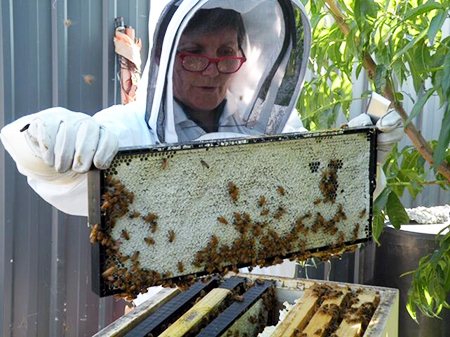
When to Harvest Honey
Collecting honey depends on three factors:
- Time of the Year
- Time of the Day
- Weather
Time of Year
The time of year will depend upon where you live. In warmer climates, the harvesting season will be longer, and more than one harvest might be taken. In cooler climates, the time to harvest will be shorter.
In Australia, I live on the mainland in the most southern location. In our climate, I usually harvest in late Spring and possibly another harvest is taken in late Summer. This only occurs if the hive is strong and there is a strong nectar flow.
Some seasons produce more honey than others and it depends upon the abundance of available flora and the weather conditions.
In other countries and climates, the timing for the harvest will vary. If you are only starting out and feel unsure about the best time to harvest in your area, it might be a good idea to seek out other local beekeepers and ask them about it.
Time of Day
Where I live it’s best to remove honey between the hours of 11 am and 4 pm approximately. Between these hours the bees are most actively out foraging, so there are fewer bees in the hive to be concerned about.
Depending upon where you live, your harvesting time may be longer or shorter. Harvesting at night is not an option. The weather will be cooler, and you risk the health of the colony. Plus, the bees would not like to be disturbed while they are sleeping!
Weather
Harvest the honey on a warm, calm and sunny day above 18 degrees Celsius. (64 degrees Fahrenheit). At this time many bees will be out collecting nectar and pollen, so once again there are fewer to be concerned about you removing honey.
How Much Honey Should I Harvest?
How much honey you will harvest depends on your local weather conditions and the strength of your hive. Discuss this with the members of your local bee club.
I err on the side of caution and take frames of honey that are about three quarters capped on both sides. If cells are open and nectar falls out, then that frame isn’t ready to be taken.
I leave the colony the equivalent of four full frames of honey spread across a number of frames. This is just in case the weather turns cold and the bees cannot leave the hive to forage.
I also don’t take honey from a colony in their first year, preferring them to become a very strong colony. In subsequent years, the honey harvest should be more plentiful.
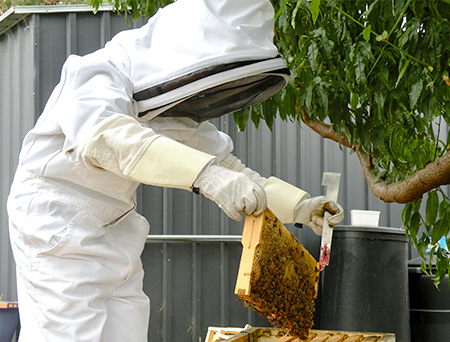
How to Harvest Honey
Preparation
Before you harvest honey, you need to consider where you are going to extract the honey because it needs to be bee-proof and cleaned easily.
Honey is extremely sticky and gets onto everything! The worker bees will smell the honey and follow you, so I use a large, strong plastic tub to securely store the honey frames once I have removed them.
I use my laundry as my extraction room as it has a tiled floor, a sink and immediate access to the yard, making the clean-up relatively easy.
Gather all the equipment you are going to use and allow yourself enough time to harvest the honey.
It’s best to extract as soon as you can after you have removed the capped frames because the honey is nice and warm and is easy to extract. The warm weather also helps speed up the extraction process.
You will need:
- Some food grade buckets with lids and taps at the bottom
- A double strainer or sieve – This sits over your food grade bucket and strains the wax out of the honey.
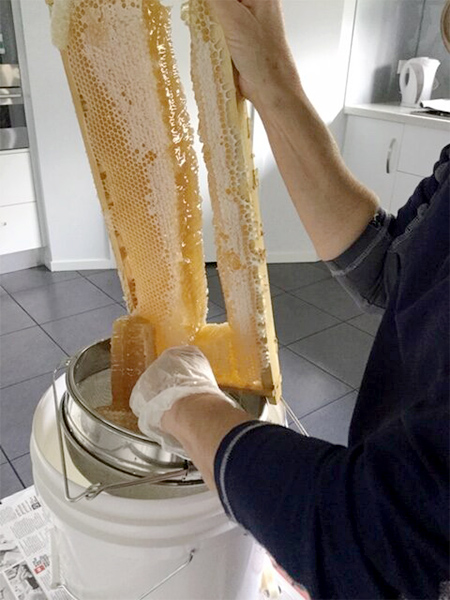
- A manual or electric extractor – Suitable if you plan to extract many frames at once.
- An uncapping knife – This will be used to remove the wax capping to release the honey. The advantage of one of these is that it will remove the capping in sheets. I use two large kitchen knives heated in hot water to more easily cut through the capping.
- A capping scratcher – This tool can reach where the uncapping knife will not, but it produces a lot of wax particles that can block the sieve.
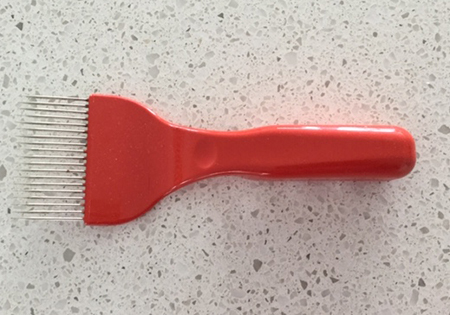
All these supplies can be bought from a beekeeping supply store, online or your local beekeeping club may have some of them.
If you want to buy an extractor, ask members of your club where they buy their extraction equipment. Many beekeeping clubs hire extractors to members which is much cheaper than buying your own. The food-grade buckets may be also purchased from a hardware store.
Using A Sieve Or Strainer
If you don’t have an extractor or access to one, you can use a sieve or strainer to filter your honey. This method is inexpensive and simple, but it takes longer.
Place your sieve over your bucket. I balance the heavy honey-filled frame on a length of wood suspended across the bucket and swivel the frame around as I cut the honey, so it falls (mostly!) into the sieve.
To begin, cut the capped comb away, beginning just under the first frame wire and leaving the comb above the wire untouched. This gives the bees a starting strip of comb when the frame is returned to the hive. It’s a good idea to cut half a length between the wires each time so it will fall into the sieve.
Gravity causes the honey to run out. This process can be sped up by cutting into the comb with a knife from time to time.
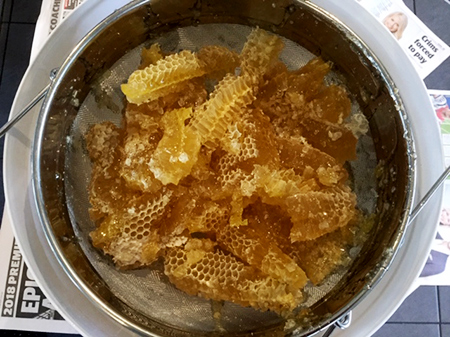
Using An Extractor
I use a three-frame manual extractor when I have many frames to harvest. It’s faster and unlike the previous method the comb is not cut away, only the capping removed. This leaves the drawn comb mostly intact and the bees can simply begin filling the cells again when returned to the hive.
To remove the wax capping you can use a knife warmed in hot water and dried, an electric knife or a capping scratcher.
I sometimes use a capping scratcher, although it has the disadvantage of possibly blocking the sieve because it produces a lot of wax particles. As a result, you will have to clean the sieve more often.
Over one on your food grade buckets, scratch the wax capping off both sides of the frame then place it into your extractor. Repeat with each frame until the extractor is full.
Using a heated or electric knife has the advantage of removing the capping in one sheet so the sieve is not blocked. Use a downward sawing action and the sharp edge of the knife will slice through. A scratcher can be used where the knife may not reach.
The extractor will include instructions as to how to load the frames and in which direction the extractor needs to spin in order to remove the most honey.
If you are using, for example, a three-frame extractor and only two frames left to extract, you will need to put an already extracted frame into the vacant spot, so the extractor remains balanced during operation.
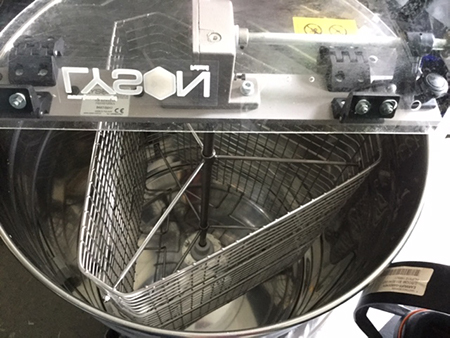
As soon as is practicable, return the frames to the hive so the bees can clean them and reuse them to store honey.
If you can’t or don’t want to, you can place the frames into plastic bags, tie them up and place them into your freezer for 48 hours. This will kill any wax moth larvae and you can then store the frames in a secure tub ready for next season.
Conclusion
Extracting honey from your hive is an enjoyable, rewarding experience. It is a seasonal task that can be performed inexpensively and easily, just make sure you are organized. Beekeepers can extract their honey manually or using an extractor.
Have all the necessary equipment prepared the day before, ensuring you are extracting on a day when the weather is warm, and the honey will flow readily. A secure area free of bees is essential too.
If you have questions, ask a local beekeeper or a member of your nearest beekeeping club. They will be happy to assist.
